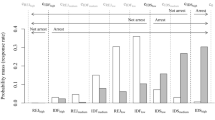Abstract
DNA profiling can be used to identify criminals through their DNA matching that left at the scene of a crime. The strength of the evidence supplied by a match in DNA profiles is given by the likelihood ratio. This, in turn, depends upon the probability that a match would be produced if the suspect is innocent. This probability could be strongly affected by the possibility of relatedness between the suspect and the true source of the scene-of-crime DNA profile. Methods are shown that allow for the possibility of such relatedness, arising either through population substructure or through a family relationship. Uncertainties about the likelihood ratio have been taken as grounds for the use of very conservative estimates of this quantity. The use of such conservative estimates can be shown to be neither necessary nor harmless.
Similar content being viewed by others
References
Balazs, I., 1993. Population genetics of 14 ethnic groups using phenotypic data from VNTR loci, pp. 193–210 in DNA Fingerprinting: State of the Science, Edited by S.D.J. Pena, R. Chakraborty, J.T. Epplen and A.J. Jeffreys. Birkhäuser Verlag Basel Boston Berlin.
Balding, D.J. & P. Donnelly, 1994. How convincing is DNA evidence? Nature 368: 285–286.
Brookfield, J.F.Y., 1992. The effect of population subdivision on estimates of the likelihood ratio in criminal cases using single-locus DNA probes. Heredity 69: 97–100.
Brookfield, J.F.Y. The effect of relatives on the likelihood ratio associated with DNA profile evidence in criminal cases. J. Forensic Science Soc. (In press).
Budowle, B. & K.L. Monson, 1993. The forensic significance of various reference population databases for estimating the variable number of tandem repeat (VNTR) loci profiles, pp. 177–192 in DNA Fingerprinting: State of the Science. Edited by S.D.J. Pena, R. Chakraborty, J.T. Epplen and A.J. Jeffreys. Birkhäuser Verlag Basel Boston Berlin.
Chakraborty, R. & K.K. Kidd, 1991. The utility of DNA typing in forensic work. Science 254: 1735–1739.
Chakraborty, R., M.R. Srinivasan & S.P. Daiger, 1993. Evaluation of standard error and confidence interval of estimated multilocus genotype probabilities, and their implications in DNA forensics. Am. J. Hum. Genet. 52: 60–70.
Cohen, J.E., 1992. The ceiling principle is not always conservative in assigning genotype frequencies for forensic DNA testing. Am. J. Hum. Genet. 51: 1165–1168.
Devlin, B. & N. Risch, 1992. Ethnic differentiation of VNTR loci, with special reference to forensic applications. Am. J. Hum. Genet. 51: 534–548.
Evett, I.W., 1992. Evaluating DNA profiles in a case where the defence is ‘It was my brother’. J. Forensic Science Soc. 32: 5–14.
Jeffreys, A.J., J.F.Y. Brookfield & R. Semeonoff, 1985. Positive identification of an immigration test-case using human DNA fingerprints. Nature 317: 818–819.
Jeffreys, A.J., M. Turner & P. Debenham, 1991. The efficiency of multilocus DNA fingerprinting probes for individualization and establishment of family relationship, determined from extensive casework. Am. J. Hum. Genet. 48: 824–840.
Jeffreys, A.J., V. Wilson & S.L. Thein, 1985a. Hypervariable ‘minisatellite’ regions in human DNA. Nature 314: 67–73.
Jeffreys, A.J., V. Wilson & S.L. Thein, 1985b. Individual-specific ‘fingerprints’ of human DNA. Nature 316: 76–79.
Kaye, D.H., 1993. DNA evidence: probability, population genetics, and the courts. Harvard J. Law Tech. 7: 101–172.
Lewontin, R.C. & D.L. Hartl, 1991. Population genetics in forensic DNA typing. Science 254: 1745–1751.
Morton, N.E., 1992. Genetic structure of forensic populations. Proc. Natl. Acad. Sci. USA 89: 2556–2560.
Morton, N.E., A. Collins & I. Balazs, 1993. Kinship bioassay on hypervariable loci in Blacks and Caucasians. Proc. Natl. Acad. Sci. USA 90: 1892–1896.
National Research Council, 1992. DNA technology and forensic science. National Academy Press. Washington DC.
Nichols, R.A. & D.J. Balding, 1991. Effects of population structure on DNA fingerprinting analysis in forensic science. Heredity 66: 297–302.
Risch, N. & B. Devlin, 1992. On the probability of matching DNA fingerprints. Science 255: 717–720.
Wong, Z., V. Wilson, I. Patel, S. Povey & A.J. Jeffreys, 1987. Characterisation of a panel of highly variable minisatellites cloned from human DNA. Ann. Hum. Genet. 51: 269–288.
Weir, B.S., 1992. Independence of VNTR alleles defined by fixed bins. Genetics 130: 873–887.
Weir, B.S., 1993. Population genetics in the forensic DNA debate. Proc. Natl. Acad. Sci. USA 90: 11654–11659.
Weir, B.S. & I.W. Evett, 1992. Whose DNA? Am. J. Hum. Genet. 50: 869.
Wright, S., 1943. Isolation by distance. Genetics 28: 114–138.
Author information
Authors and Affiliations
Additional information
Editor's comments
The author makes a good case for the use of likelihood ratios in presenting evidence. The author cites Nichols and Balding (1991) for the match probability involvingF ST , and readers will also need to consult Balding and Nichols (1994 and this volume) and Weir (1994). In light of current concern over laboratory errors or fraud, the author's comment that ‘Undetected and unsuspected human error or mischief is potentially a problem in almost all criminal cases, yet no convictions could follow if this possibility was consistently deemed to lead to reasonable doubt’ is well taken.
Rights and permissions
About this article
Cite this article
Brookfield, J.F.Y. The effect of relatedness on likelihood ratios and the use of conservative estimates. Genetica 96, 13–19 (1995). https://doi.org/10.1007/BF01441147
Received:
Accepted:
Issue Date:
DOI: https://doi.org/10.1007/BF01441147




